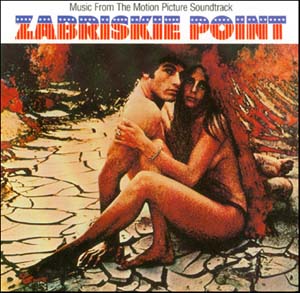Your Cart is empty
Subtotal£0.00
Your order details
Your Cart is empty

With their genius for strange, huge soundscapes, relentless technical invention and mastery of mood, there can be no band in rock better suited for continued excellence on movie soundtracks than Pink Floyd.
In 1967, they performed on Tonite Let's All Make Love In London, a documentary about the swinging Sixties, baby, that featured everyone who was anyone - John and Yoko, Mick Jagger, Michael Caine, David Hockney, Vanessa Redgrave and so on. It's distinguished by a very long early take of 'Interstellar Overdrive'; the original album left off an instrumental 'Nick's Boogie', but the CD version has this on.
They provided the soundtrack for the unsettling, Kafkaesque 1968 film The Committee, about an unnamed man who murders an acquaintance for no apparent reason, decapitates him and then sews his head back on. The man then meets the victim, apparently not dead after all, several years later and discovers that they are both on some sort of committee that runs everything in the world. Or nothing. Try not to freak out. Recorded in May 1968, this is some of the very first music that David Gilmour made with the Pink Floyd. It's sparse, obscure, stuff - hard to listen to because the audio track of the movie, the characters speaking, runs over the top of the music. Perfectly fitting for this confusing, intelligent film though. Arthur Brown's 'Fire' is used in this movie as well.
They were commissioned to do the soundtrack for the 1969 French film More, by the director Barbet Schroeder. It follows the tragic descent of a student into heroin addiction and death in Ibiza. Modelled on the myth of Daedalus and Icarus, na�ve Stephan is drawn too close to the sun that is beautiful American druggie Estelle - played by the peculiar, alluring and splendidly-named American actress Mimsy Farmer - and lured to his eventual horsey doom. Very much a flick of its time, the soundtrack does sterling work attempting to recreate something cinema has consistently, perhaps inevitably, failed to do: convey accurately the sensations of being off your rocker on the drugs. The Floyd album More - which was considerably more commercially successful than the film - features some cool tracks, notably birdsongy, acoustic 'Cirrus Minor' and blissed out, dripping 'Cymbaline'. A lot of the tracks on this were worked up into live staples throughout the coming years.
After the recording of Ummagumma later that year, Floyd were asked to contribute to the soundtrack of Zabriskie Point, director Michael Antonioni's follow-up to Blow Up.Pink FloydThe film - a stone-cold counterculture classic - follows hippie chick Daria and activist boyfriend Mark as they steal a plane, paint it trippy colours, make love, wig out and get involved in an orgy at Zabriskie Point in Death Valley. Yeah baby.
Floyd contributed several songs: 'Come in Number 51, Your Time Is Up', a reworking of 'Careful with That Axe, Eugene', which remains one of our all-time favourite song titles. Richard Wright did a solo piano piece 'Love Scene (Version Four)', there was a song about chess (as you do) called 'Country Song' and 'Rain In The Country', an instrumental. The disorientating, multi-layered 'Heart Beat, Pig Meat' opens the soundtrack album and, rather oddly, there is also a sort of up-tempo country number called 'Crumbling Land'. It's well worth checking out this soundtrack - which also features The Grateful Dead and several Gerry tracks. The Stones 'You Got The Silver', a gem of a song, was in the film but not on the album, while Jim Morrison wrote 'L'America' for the movie only for Antonioni to reject it.
In 1972, Floyd hookedup with Barbet Schroeder again, to provide the music for his film The Valley. This soundtrack is generally known by the album title Obscured By Clouds. The production of the soundtrack was pretty tight: the band had only two weeks to get it all done, working from a rough-cut of the film and timing sequences with stopwatches. There is some early use of synthesiser techniques by Richard Wright that he would expand on throughout his career - including the use of a droning note to open the album, a stylistic trick that would be employed in concerts for several years. The album is also notable for including the song 'Free Four', which was the first Floyd song to receive significant US airplay. The film is about a woman who gets lost in the Papua New Guinea jungle and goes on a voyage of self-discovery when she meets tribes untouched by 'civilised' society and all its hypocrisies and flaws. A bit like going to some bits of Scotland today.
In 1992 - and this is real rockristocracy excess as it should be enjoyed - David Gilmour and Nick Mason decided they wanted to compete in the Carrera Panamericana rally in Mexico. Gilmour crashed, and his map-reader Steve O'Rourke - the band's manager - suffered a broken leg. A mixture of previously released stuff like 'Run Like Hell' (although not for Steve, ha, ha) and 'Sorrow' was augmented by original compositions.
No look at Pink Floyd's soundtrack work could be complete without mention of the superbly overwrought and ambitious project that was The Wall nor, of course, The Dark Side Of The Rainbow theory about the synchronicity between the band's magnum opus and the Judy Garland movie. Whether that is true or not, there's no doubt that Pink Floyd had a terrific gift for creating soundtracks that brilliantly enhanced and evoked the movies they were accompanying.